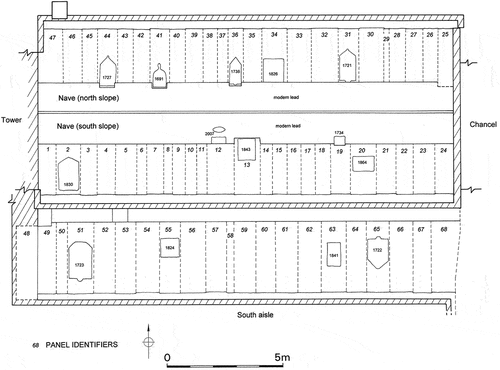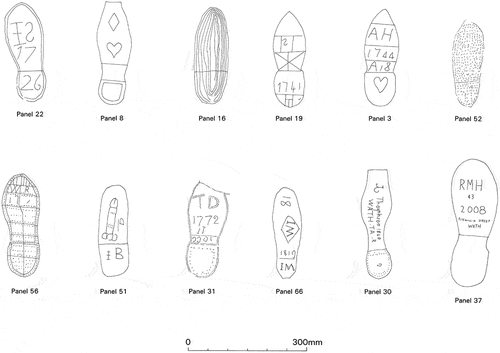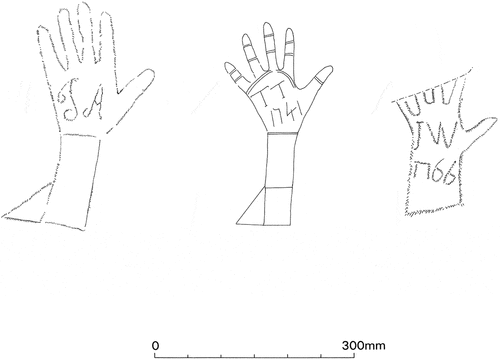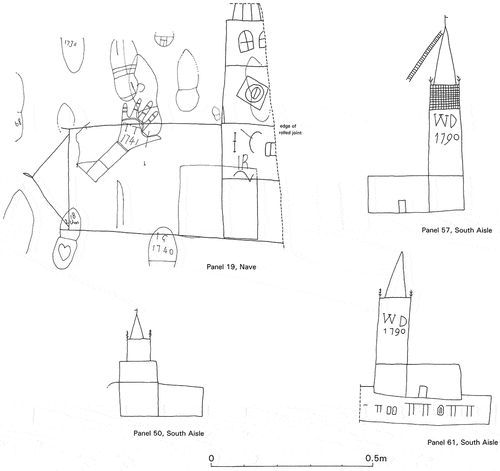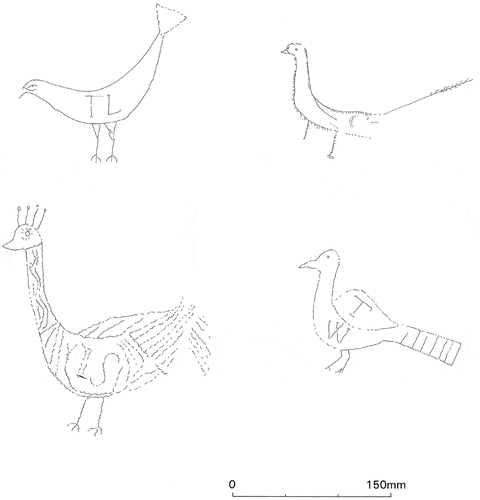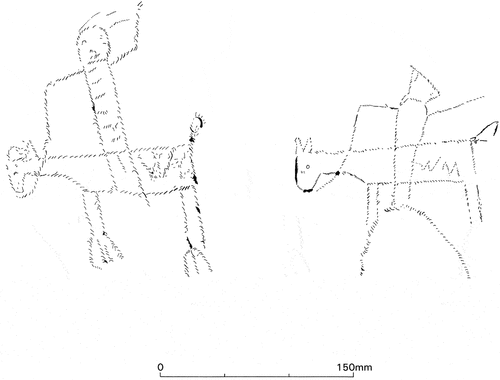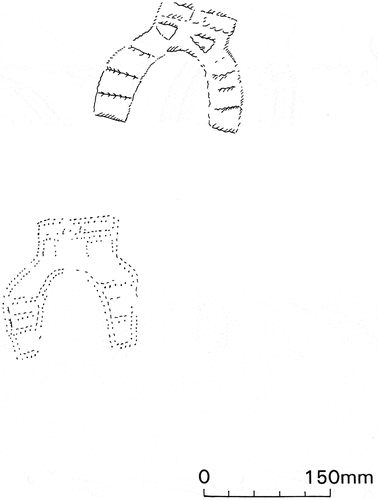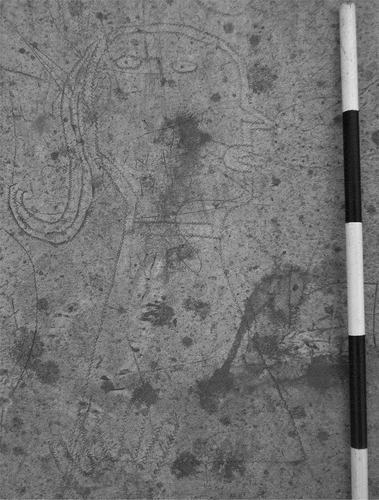ABSTRACT
The leaded roofs of the nave and south aisle of All Saints Church, Wath Upon Dearne, South Yorkshire, are covered in graffiti dating from between the early-seventeenth and the twentieth centuries. The graffiti, along with other features such as plumbers’ plaques, was the subject of archaeological recording in 2013. This paper discusses the form of the graffiti, and what information it preserves about the spiritual, folk and community beliefs of those who made it. Its potential for understanding changes to the fabric of the church itself is also examined.
Introduction
The Grade I listed All Saints Church is located within the north-east part of Wath Upon Dearne, on the north side of Church Street. The surrounding churchyard extends to the north, east and south, although the majority of the gravestones have been cleared, with few monuments remaining standing. The history of both church and parish has been subject to previous detailed accounts, and so is not repeated here.Footnote1
In summary, the church is thought to have pre-Conquest origins, possibly with some fragmentary structural remains surviving to the interior, and to have comprised a nave and chancel. The north nave aisle and Lady Chapel were added in 1145–50, and the lower part of the tower in 1175. The chancel was extended in 1230, replacing the earlier apsidal end with a square end, and the Lady Chapel was enlarged in 1290–95. The south nave aisle was built between 1305–20, with further small additions, principally the south porch and vestry, at the end of the fourteenth century; at the same time as the latter, or perhaps in the early-fifteenth century, the tower was heightened and a short spire was built. The nave was re-roofed in 1540. The present octagonal spire was added in 1714, when the first clock was installed in the tower. An organ chamber was built on the south side of the chancel in 1868, during a major restoration of the church which included work to the spire also. Following a fire in 1917, further restoration took place in 1920 when the organ chamber and choir vestry were enlarged and a clergy vestry added. The tower parapet was rebuilt in 1935. More recently, in 1975, the tower was restored, while in 1990–91 the roof of the Lady Chapel and eroded stonework were repaired.Footnote2
An archaeological survey of the graffiti and other features such as plumbers’ plaques on the nave and south aisle roofs was undertaken in 2013 on behalf of All Saints Church Parochial Church Council.Footnote3 This was done to provide a detailed pre-intervention record prior to a programme of repair and renovation to the roof structure and its lead covering. The survey comprised a drawn, photographic and written record. Throughout this paper, comparison is made with the graffiti on two other church roofs that were subject to subsequent detailed archaeological recording, those of the Beauchamp Chapel at the Collegiate Church of St Mary, Warwick and the tower roof of St Oswald’s Church, Filey, North Yorkshire.Footnote4
The church roof
The nave roof at Wath was shallowly pitched, and comprised forty-seven panels of lead sheets; the panels were all approximately 3.50 m long from the roof edge to the ridge, although there is a band of modern repair along both sides of the ridge, meaning that the exposed portion of the historic panels was only 2.20 m long (). The panels vary between 0.50 m and 1.20 m in width, with standing rolled seams between each panel. The south aisle roof comprised twenty-one panels of lead sheets, averaging 2.80 m in length and 0.95 m in width, again with standing rolled seams between each panel. In order to locate the recorded graffiti, the roof panels were numbered sequentially, commencing at the west end of the south slope of the nave roof and moving east (Panels 1 to 24), then from east to west along the north slope of the nave roof (Panels 25 to 47) and finally from west to east along the south aisle (Panels 48 to 68) (); a panel was defined as being the area between two rolled seams, or between a rolled seam and the end roof coping. These panel numbers are referred to in the following text and accompanying figures.
In terms of the date of the roof panels, the nave was re-roofed in 1540, and so none of the existing panels can be earlier than this. The earliest plumbers’ plaques and dated graffiti on the nave were all from either the late-seventeenth century or the early-eighteenth century. The plaques would not have been used to commemorate minor campaigns of work, and so it is likely that much of the earliest surviving nave lead is also of the same period. It is not known if or when the south aisle was re-roofed, but the earliest plumbers’ plaques and graffiti are all from the early-eighteenth century, and so again it is suspected that many of the panels are probably late-seventeenth century or early-eighteenth century in date.
At the time of the 2013 survey, the only access to the nave and aisle roofs was by long ladders. An enclosed newel stair rises up the south-west corner of the tower to the embattled parapet and recessed octagonal spire, but there is no access from inside the tower to the nave roof. Similarly, although the east face of the tower preserves clear evidence for the steeply pitched earlier nave roof and blocked two-light former belfry openings, there is again no clear surviving evidence for access to the existing nave roof. Unless all evidence was removed during the major restoration of 1868, it is therefore possible that since at least 1540, the only access to the nave roof was through ladders or perhaps occasionally scaffolding. This has important implications for who was able to get onto the roof and create the graffiti.
The plumbers’ plaques
A total of ten plumbers’ plaques was present on the roof of the nave (five to the north slope and five to the south slope), with a further four examples to the south aisle (). The plaques vary in date between 1691 and 2007, although the majority fall either within the 1720s or between the 1820s and the 1860s. Very few coincide with known major episodes of work on the church, although it is possible that some are associated. For example, in 1726 the pews were reconstructed and the rood-loft removed, with further works in 1729.Footnote5 Might the three plaques dated to the consecutive years of 1721 (nave panel 31), 1722 and 1723 (south aisle panels 65 and 51 respectively) commemorate works to the roof which formed part of the same scheme, making it watertight before internal works commenced?
The same individual or firm of plumbers is commemorated several times. This is not unusual, a similar pattern having been noted on the roofs of other South Yorkshire churches.Footnote6 At Wath, the roofing work was concentrated in the hands of two families. It is highly likely that the ‘I C PLUMAR’ who appears on the earliest dated plaque of 1691, was related to the John Clarke commemorated as plumber in 1721, 1723 and 1727. In turn, the ‘Samuel Clark’ named in 1738 () was almost certainly related to John Clarke. During the nineteenth century, the Ridgill family took over as plumbers, and the progression of the firm from J Ridgill in 1826, through Ridgill and Son in 1843, to R and W Ridgill in 1864 can be followed through the plaques. The names of the relevant vicars appear infrequently on the plaques, but those of the church wardens are always recorded, as befits their responsibility for the upkeep of the fabric of the church. The wardens were not just recorded on the roof leads, but left their mark on other elements of the fabric; for example, three pieces of timber from the bell tower kept inside the church bear the carved names of five churchwardens from 1741. The tradition of commemorating work to the roof and elsewhere did not die out, but after the late-nineteenth century, the commemoration of workmen became less elaborate. For example, on the nave panel 37, there is a simple stamp for ‘W W Evers Plumber & c Wath’, with ‘Matthew Evers 1863’ also appearing on the nave panel 8; the Evers were another local family, with several members being buried in the graveyard around the church, and they also served as church clerks. There are, furthermore, several examples of scratched or cut graffiti commemorating twentieth-century plumbers, whilst the scratched inscription ‘B HIBBERD, D SHAW, E TAYLOR 1972 WINDOW MEN’ was recorded on the south aisle panel 48.
The graffiti
Distribution and making
In terms of distribution, there is a clear bias towards surviving graffiti on the south slope of the nave at Wath, which is almost certainly due to differential weathering; the lead panels on the north slope are both more worn and considerably dirtier. Although the volume and density of the surviving graffiti, particularly to the south aisle, is undeniably impressive, it is difficult to make any definitive statements as to whether it is unusual or not. The roof of the Beauchamp Chapel at Warwick comprised 42 panels covering approximately 155.5 square metres and retained a total of 794 recorded graffiti. The tower roof of St Oswald’s Church at Filey comprised 56 panels covering approximately 59 square metres and retained 1482 legible graffiti.Footnote7 At Wath, subtracting the area of the nave roof ridge covered by modern lead panels and therefore obscuring any graffiti that might lie beneath on the earlier panels, the nave and south aisle have a combined area of approximately 138.7 square metres, across which at least 957 legible graffiti were present.
Using this simplistic method, of the three churches Filey has by far the highest density of graffiti. Such comparisons are of course somewhat crude and must be couched with caveats. Overall numbers will be affected by the condition of the lead, the proportion of older to more recent panels and the nature of the graffiti, with elaborate pictorial graffiti taking longer to make than simple paired initials. Nevertheless, as more church roofs are recorded in detail, the relative densities of graffiti from one to the other will become significant to both understanding and conservation. However, of greater importance to understanding is the form and types of graffiti concealed within the overall numbers. For example, although the density of graffiti was greater at Filey, the most common form was simple sets of initials, whereas these were apparently infrequent at Wath. By contrast, at Wath there were at least 841 shoe outlines as compared to 432 at Filey. Unsurprisingly, land-locked Wath had no graffiti of ships, whereas coastal Filey retained 47 examples, some of them complex depictions of fully rigged sailing vessels.Footnote8 It is through analysis of these variations that a better appreciation of the motives and concerns of the local community making the graffiti will emerge.
Some of the graffiti was made by cutting, incising or scratching the surface of the leads, using a knife or other bladed tool, but the majority of the graffiti at Wath was created by repeatedly making small, slightly curved, indentations or marks in the surface of the lead. In some cases, a very faint incised line was visible beneath the curved marks acting as a guide. The curved marks often run parallel, but are sometimes opposed to create a repeating zig-zag, herringbone or V-shaped pattern; this same technique was recorded with eighteenth and nineteenth-century graffiti on the leaded roof of Bolton Castle, Wensleydale, North Yorkshire,Footnote9 at Warwick and at Filey. BuglassFootnote10 categorizes this technique as ‘wrigglework’, where a suitably shaped tool (something like an engraver’s graver tool, a small woodworking chisel or a leatherworker’s V-racer) was pushed over the surface at a forty-five degree angle whilst being rocked (wriggled) from side to side. At Warwick, the tool was suggested to be something like a roller with a patterned surface, and there was a clear correlation between this method and dates, with most of the rolled graffiti occurring before 1820.Footnote11
Shoe and hand outlines
By far the most common form of graffiti at Wath were shoe or boot outlines. At least 841 examples of shoes were visible, with 305 recorded to the nave and 536 to the south aisle. Many of the shoes have letters and/or dates placed within them (usually on the flat of the sole), and whilst in a few instances it is possible that shoes were appropriated by later initials, for the vast majority the style or form of the marking used strongly suggests that all parts of the graffito are contemporary. Approximately 104 of the shoes were legibly dated, the earliest three being from 1712, 1725 and 1726 respectively; discounting very modern examples, the most recent legibly dated shoes were from 1840 and 1847. The majority of dated shoes fell between the 1730s and 1790s, with the highest number (almost a quarter of the total) belonging to the 1760s. Very few predate these decades, in a marked contrast to the plumber’s plaques which were made either between 1691 and 1738 or between 1824 and 1864. Some marks on the shoes might provide further personal information; for example, one shoe had ‘A18’ in conjunction with ‘AH 1744’, possibly denoting that the maker was aged eighteen in 1744.
The shoes were broadly of three types, having rounded, pointed and square/flat toe ends (). Of these, the rounded type was the most common, followed by pointed, with square/flat examples in much smaller numbers. A similar pattern was recorded at Filey, where rounded toes were by far the most numerous, followed by square toes and pointed toes; here, four of the six dated square-toed shoes belonged to the later seventeenth-century.Footnote12 By contrast, very few of the square-toed shoes at Wath were dated, and those that were fell into the 1840s. The rounded shoes covered a very wide range of eighteenth-century dates, with the pointed shoes tending towards the mid to later eighteenth-century. As elsewhere, it was difficult to distinguish between left and right shoes, largely due to the fact that before the first half of the nineteenth century there was no differentiation between the two in shoe design.Footnote13
Overall, the shoes average between 0.24 m to 0.26 m in length, the larger average being equivalent to a modern size nine. Tracing around the shoe would probably tend to produce a slightly over life-sized image,Footnote14 but even so, the majority of the shoes are realistically sized. Although there are a small number of shoes where the heels are upwards (i.e. pointing towards the apex of the roof), the vast majority are positioned so that the toe points upwards; again, the same pattern was noted at Filey and at Warwick.Footnote15 Both nave and aisle had examples that were aligned across the roof slope rather than along it, often as a result of fitting the shoe in between earlier graffiti. With the shoe outlines towards the base of the roof slopes, it would have been possible for an individual to stand in the gutter, place their foot on the lead and simply trace around the shoe without removing it. However, for the outlines further towards the apex, the individual must either have actually climbed onto the leads or removed their shoe or boot, placed it against the lead, traced around the outline and then filled in whatever detail they wished.
Some of the shoes include realistic details of construction, including heel blocks, hobnails and the lines of stitching used to attach the sole and welt to the upper. Others incorporate hearts. Heart symbols on hands have been suggested as being possibly apotropaic, whilst hearts on shoes are interpreted as declarations of love.Footnote16 It seems just as likely that those at Wath could be interpreted in terms of contemporary popular or folk art and advertising. The heart was a common eighteenth- and nineteenth-century popular or folk art motif in England,Footnote17 whilst the practice of creating a heart pattern on the sole of a shoe or boot using brass nails was employed on the over-sized examples used as trade emblems or advertising signs outside cobbler’s shops, and in the window displays of the same premises.Footnote18 Perhaps surprisingly on a church roof, one shoe to the south aisle (panel 51) incorporated a phallic design, whilst the aisle also preserved the only example of a bare foot (panel 67) on the entire recorded roof area.
After shoes, hands were the second most common form of graffiti seen on the roof, with at least 85 examples being present (37 to the nave, and 48 to the south aisle). They averaged 0.20 m in length, including a section of wrist, suggesting that they are life-size, and were created by tracing around the maker’s hand (). A few examples were over 0.30 m long, the greater length being created by a longer ‘wrist’, so that the finished graffiti more closely resembled a glove or gauntlet, sometimes with a simple cuff added. Some had lines scored across the fingers to represent joints in the skin, or possibly folds on a glove. A small number formed pairs with adjacent shoes (for example, on panel 12 of the nave), but most of those making the graffiti chose to commemorate themselves only using a single shoe or a single hand in any one place. Only seven of the 85 recorded hands were legibly dated, the dates being widely spaced between 1725 and 1793. Where it was possible to distinguish, the vast majority of hands (35) were left-handed, with only three right-handed examples noted. This reflects the prevalence of right-handedness, with these people placing their left hand against the lead. A similar difference in relative numbers was noted at Filey.Footnote19
In stark contrast to Warwick and Filey, where they were present in large numbers,Footnote20 Wath has an apparent lack of simple paired initials and dates that were not placed within shoes or hands. Even allowing for weathering and the fact that they might be overwritten by later images, only relatively few definite examples were noted and certainly less than these other two churches. In terms of the lettering used within the shoes and hands, the vast majority was formed by capitals. The letter ‘I’ with a cross-bar occurs fairly frequently, and the use of cross serifs and beaks is also common to the termini of a letter. There were a small number of examples where double line stems were used to emphasize a letter, and also the occasional use of cursive script, such as ‘The pride of Bay (illegible)’ on the aisle. In some cases, style of the lettering demonstrates that the maker of the graffito must have taken several different tools onto the roof with them. For example, on nave panel 12, for the letter ‘W’, the body has been made using a tool producing the herringbone pattern, and then the upper terminals emphasized by pushing a pointed, round-section, tool into the lead to form a ball.
Works to the church fabric
The graffiti and other recorded roof features have the potential to inform various repairs to the church fabric in several different ways. At the most basic level, by combining the graffiti with other structural information such as the differing forms of the rolled joints between lead roof panels and the direction of the roll, it is possible to discern how panels were replaced or re-ordered over the years. Once such a sequence has been established (as far as it possible), examination of specific groups of features and graffiti can provide a wider context for the bare structural information.
Four drawings or sketches of churches appear on the roof of All Saints (). The largest, almost 0.75 m square and initialled ‘I C’ (nave panel 19), is a representation of All Saints Church itself, depicting the north elevation of the four stage tower in enough detail to make identification possible. The sketch is undated but must post-date 1741 as it is cut across a hand of this date. Two sketches of All Saints on the south aisle (panels 57 and 61) are both by the same hand, initialled ‘WD 1790’. One, looking south, includes a ladder leaning against the spire, suggesting that the maker may have been a steeplejack involved in late-eighteenth-century repairs, whilst the other, looking north, shows churchyard monuments which have since been partly cleared. Where the spire is visible on these graffiti, it is the tall, post-1714, existing structure which is shown, along with the original crocketted pinnacles. However, a third sketch of a church on the south aisle has a more squat tower and spire, again with crocketted pinnacles. It may be no more than a cruder rendering of All Saints, but the intriguing possibility exists that the shorter, late-fourteenth-century spire is shown; the sketch could therefore pre-date 1714, or perhaps be made by someone remembering the earlier spire after 1714.
The spiritual and political
A single example of a small, circular, compass-drawn design or ‘daisy wheel’ survived on the nave (panel five). Such marks occur in a range of secular and ecclesiastical settings, and are generally interpreted as having an apotropaic or protective function; in secular buildings, they are often placed near openings such as doorways, windows and chimneys.Footnote21 Their importance is that they are made in the form of an ‘endless line’, the idea being that evil is attracted to lines and will always follow them to their end; therefore, in an endless line, the evil can never stop following and traps itself within the symbol. They occur very commonly within medieval churches, usually with a wide spatial distribution throughout the building, but their presence on roof leads is less commonly referred to.Footnote22 At Warwick, as at Wath, only a single example of compass-drawn design was identified on the roof. Wath’s south aisle also preserved the only example noted of a quartered circle, perhaps representing a cross set within a circle; again, crosses were relatively scarce on the roof at Warwick as well.Footnote23 Painted gold writing on a single panel on the nave, although worn, included the words ‘Solstice Eve’ and symbols which suggested that it related to modern neopagan belief; their placement on a church roof could be interpreted as a subversive act.
Turning to the political, two of the plumbers’ plaques on the nave roof (on panels 13 and 34, dated to 1843 and 1826 respectively) incorporate the same abolitionist symbol (). A kneeling slave is shown in profile, with chains hanging down from his arms, and the title ‘HUMANITY’ beneath. The figure is clearly derived from Josiah Wedgwood’s famous 1787 design ‘Am I Not A Man And A Brother?’. The design, adopted in October of that year as the seal of the London Committee for the Abolition of the Slave Trade, was produced as a small black and white jasper medallion by Wedgwood from early 1788 and thousands of these cameos were subsequently produced. They were sometimes turned into items of jewellery such as bracelets or mounted on snuff boxes, and some of Wedgwood’s Staffordshire competitors began to produce copies, so that the image gained wide currency. It was then incorporated into other artefacts such as trade tokens, ceramics and glass, as well as limited use on books and pamphlets, and became the most widely recognized symbol of visual abolitionist culture. However, abolitionist imagery in a church is extremely rare, and so the Wath images, even though on the roof, are of considerable interest.Footnote24
PLATE 3. Detail of abolitionist image incorporated into 1826 plumber’s plaque, nave roof (panel 34) (0.50 m scale).

Britain banned the importation of African slaves into its colonies in 1807, with slavery abolished throughout the British Empire as a result of the 1833 Slavery Abolition Act. The kneeling figure on the 1826 Wath plaque appears to be contemporary with the plaque, and so would fall into the period between the 1807 and 1833 Acts. The figure on the 1843 plaque has been soldered on and so might be a later introduction, although it could of course have been re-used from elsewhere on the roof in 1843 or simply added when the plaque was already in place; it is however worth noting that there was a World Anti-Slavery Convention in London in 1843.Footnote25 In the late-eighteenth century, grass roots support for abolition was strong amongst the provincial middle classes, including Nonconformists, Anglican clergy, trade and business.Footnote26 Leeds and Sheffield, both then in the West Riding of Yorkshire, were important locations for abolitionist activity during the late-eighteenth and early-nineteenth centuries, but it has not yet been possible to identify any individual abolitionists who were active in Wath or its general area during the period when the plaques were added to the roof. Nevertheless, the incorporation of the figures into the plaques demonstrates the abolitionist beliefs of those named (the only names common to both plaques are the clerk Evers and the plumber Ridgill) and suggests the presence of such beliefs amongst the wider town community.
Other graffiti
The roof at Wath preserved examples of other images which, although much less numerous than the shoe and hand outlines, still occurred more than singly. A total of thirteen birds was recorded, on both the nave and south aisle (). Of those that could be tentatively identified, there were several resembling peacocks, with probable examples of a goose, a pheasant, a blackbird, and perhaps also a pigeon. Five horse and rider figures were recorded, occurring in relative close proximity to one another on three panels (panels 59, 60 and 67) of the south aisle (). The posing of the figures, with one hand on the reins and the other raised, is reminiscent of a rodeo rider, and it could be speculated that the influence of travelling ‘Wild West’ show advertising is present. Four curious designs resembling pairs of trousers occur on a single panel (nave panel 22) () and nowhere else, whilst a number of faces in profile was also noted. Of these, the most ambitious was the rather Picasso-esque woman on the south aisle (panel 60) (). She was undated but was made after 1793, as the design overlay a hand of this date.
Discussion and conclusions
The issue of visibility lies at the core of any understanding of historic graffiti, not just in terms of the original makers’ motives, but also in relation to its subsequent survival and the value placed upon it by archaeologists and historians.Footnote27 The related matter of access is closely bound up with visibility.
Who was making the graffiti?
Quite clearly, the graffiti can only have been made by people who had access to the church roof. At both Warwick and Filey, there was a suggested relationship between the means of access and the distribution of the graffiti. At the former, a newel stair was used to reach the roof, with a large amount of graffiti having accumulated around the top of the stair’s interior and immediate exterior. At Filey, the highest density of graffiti was found on the north roof slope, and this was thought to be partly due to people choosing not to venture too far from the access hatch at the north-east corner. Similarly, at both churches it was argued that there was what might be termed a leisure or aesthetic purpose for access to the roof leads. At Warwick, the densest concentration of graffiti was on the highest part of the centre of the south-facing pitch of the roof, which overlooks Warwick Castle, emphasizing the possible important relationship between graffiti and intervisibility with the outside landscape. At Filey, all of the dated, non-Filey place names on the roof were made after the opening of the railway line to the town in 1856, and so may represent day trippers and holidaymakers; it is possible that visits to the church roof to admire the excellent views across the bay were allowed in return for a small donation to church funds.Footnote28
It is less easy to make either case for Wath. If, as appears to have been the case for hundred of years, there was no access to nave or aisle roof other than via long ladders or scaffolding, then this would have severely restricted visitors beyond those who were carrying out works to the church fabric. The use of wrigglework to make much of the graffiti also implies access to suitable tools,Footnote29 again suggesting workmen rather than casual visitors. It is, of course, possible that an earlier route from the tower interior to the nave roof has been blocked, but even if this was so, the only access to the south aisle roof must always primarily have been via ladders and this still preserves very high numbers of graffiti. Secondly, during the eighteenth and nineteenth centuries when the majority of the graffiti was made, there were no visitor attractions like castles or sea views to admire. Nevertheless, there would have been long distance views over the low-lying ings and moor to the south of Wath flanking the River Dearne, with movement apparent along the railway lines and canal in the middle distance. The opportunity to gain an unusually elevated local viewpoint may well have been enough to tempt visitors up onto the roof when access was possible, despite the lack of an obvious focus to the modern viewer.
However, can all of the Wath graffiti really be attributed to masons, steeplejacks, and the like? The majority of the dated plaques do not correspond with known episodes of repair to the church fabric, and neither do the dated shoes. In addition, there is a marked contrast between the dates recorded on the plaques and those of the shoes, with the greatest number of dated shoes belonging to the 1760s. It is tempting to view the plaques as an officially sanctioned record of repairs to the roof, and the graffiti, such as the 1790 church with the ladder set against the spire, as the record made by those who lacked the professional status to appear on the plaques. But this would probably be an oversimplification. A proportion of the graffiti must surely have been made by non-workmen, either using a roof access now lost or perhaps even making unofficial visits to the roof when ladders and scaffolding remained in place during repairs. There were those who clearly visited more than once. The ‘J. Thompson’ who recorded his name in script in 1840 on the nave roof (panel 30) is likely to be the same ‘John Thompson’ whose script appears on the south aisle (panel 54); he was therefore on the roof at least twice in different locations, and is unlikely to have been unique. It was not possible at Wath to positively identify any female individuals, but at Filey sixteen were recognized,Footnote30 countering the common presumption that graffiti was always a predominantly male activity in the past.
Why did they make the graffiti?
The point has been made many times before that the act of making a mark, our desire to record our presence at a particular location at a particular moment in time, is as old as humanity itself.Footnote31 The urge to say ‘I was here, once’ through the medium of graffiti can be seen as an attempt to evade mortality itself, even if only temporarily; graffiti may well endure longer than its maker, but will eventually disappear even from stone.
The first question should perhaps be not why, but why here? In practical terms, the church roof lead provides a malleable surface into which it is relatively easy and quick to make a mark, and so would be attractive for this purpose alone. When one turns to the matter of visibility, the answers are less clear. Those who made their mark did so in a place that would only ever have been visible to limited numbers of people, principally those undertaking, or supervising, works on the fabric of the building. For the majority of the year, or perhaps even for years at a time, the graffiti and plaques at Wath were seen by no one, except (some might argue) perhaps God. To the author’s knowledge, there are no abolitionist images within the church similar to those used on the plumbers’ plaques on the roof. Was it enough for the men named on the plaques to know that, when the next scheme of repairs came along and a new plaque was added, those succeeding them would recognize their support for the abolitionist cause? Abolition was also a divisive issue, and there was considerable pro-slavery feeling in Britain, so in this context the images on the plaques might even be seen as acts of defiance.Footnote32 The concept of permission is also complex. Generations of church wardens must have seen the shoes and other graffiti slowly increasing in volume, and indeed must have recognized some of those making it through their initials, but its creation did not stop. Even if not actively encouraged, the making of the graffiti must have at least been tolerated by the church’s hierarchy. Such tolerance raises questions as to just how transgressive or immoral the act of graffiti making on a church roof was perceived to be during the eighteenth and nineteenth centuries.
In terms of choice of image, shoe and hand outlines are a commonly occurring form of graffiti on church roofs, and have also been recorded on the roof leads of secular buildings such as castles and country housesFootnote33; they are additionally less frequently carved into stone, as in a newel stair at Wressle Castle, East Yorkshire.Footnote34 Why make an image of a shoe on a church? Bassir, Bailey and WrightFootnote35 provide a number of interesting suggestions. The drawing of a shoe presents an easy method for a non-literate person to make their mark. The carving of a shoe may have represented the visit to a location in the same way that names and dates did to a literate person; in the case of a church porch, where business was traditionally transacted, the shoe outline could represent the equivalent of a contractual signature made in a holy place. A shoe might represent someone who was about to make a journey or had just completed one. They also highlight the practice of concealing worn-out shoes in locations such as chimneys and hearths, as a decoy mechanism to distract evil spirits that might be believed to be attempting to enter the house through such openings.
An association with the church fabric itself was seen as spiritually advantageous or beneficial. BillingsleyFootnote36 notes the belief that cutting one’s name or initials into the church brought luck, and indeed the roof lead might still retain some power even after removal; a small number of nineteenth-century West Country references records the belief that lead taken from a church roof could be used medicinally.Footnote37 Similarly, the presence of scarring on church fabric, traditionally associated with the sharpening of arrows, is now thought to be due to the collection of stone dust which was considered to have medicinal qualities.Footnote38 Mere contact with the roof lead might be enough, as in the belief recorded in Yorkshire that rain running off the church leads had restorative powers if collected and sprinkled upon the sick.Footnote39 If one pursued this further, the act of placing of the shoe against the lead to create a graffito might be seen as a commonplace variation of a contact relic, the maker not only leaving an image behind but also taking something away with them. If, for example, the creation of a ship image on church fabric can be seen as a devotional act that it was hoped would extend divine protection to a real ship and her crew at sea,Footnote40 then why not a shoe?
Amongst all of this, the prosaic, the irreverent and the everyday should not be overlooked. People in the eighteenth and nineteenth centuries may have been no less inclined to doodle or daydream than we are, and some of the graffiti may be just that; something to while away a little time in the sunshine on a roof during a break in building works, for example. Given the density of graffiti on the roof panels at Wath, the plumbers’ plaques have remained remarkably free from later additions. The three plaques (dated between 1721 and 1723 - panels 31, 51 and 65) that were subject to later graffiti had no dated additions from before 1760, and some were as late as 1790. This hiatus of 40 to 70 years could be interpreted in two different ways. It is likely that many of those making the marks were known to one another in the local community, and people may have just waited a reasonable amount of time before they defaced an earlier plaque either out of superstition or a wish to avoid conflict with another individual or family. Alternatively, later workmen may have wished to associate themselves with earlier craftsmen, and so the placing of their graffiti is in fact respectful; it is noticeable that the later graffiti added to the plaques are placed carefully between letters and words, on blank areas, whereas the surrounding roof panel is densely covered. This leads to a third possibility; their choice could have been determined by as mundane a matter as simply finding space. Although the placement of graffiti sometimes undoubtedly has complex meanings and motives, this is not always the case, and it is important to bear this in mind when interpretations are being offered.Footnote41
The parish registers that were once kept within the church form a record of the births, marriages and deaths of the local community. Up on the roof, there is another community record impressed into the leads. Created by now largely anonymous individuals, taken singly, each graffito is of local significance only. However, as a body of historical material spanning over 300 years, the graffiti and plaques at Wath enable us to see something of how national issues such as abolitionism and local political sympathies were entwined, to gauge the influence of advertising and contemporary entertainment on the local populace, and to possibly discern patterns of popular spiritual beliefs.
Acknowledgments
I am grateful to Ed Dennison for reading through an earlier draft of this paper and suggesting several improvements, and to John Billingsley for a more wide-ranging discussion of the nature of historic graffiti in Yorkshire. Professor John Oldfield of the Wilberforce Institute for the Study of Slavery and Emancipation at the University of Hull provided valuable observations on the context of the abolitionist images on the church roof.
Disclosure statement
No potential conflict of interest was reported by the author.
Notes
1. Rev. W. Keble Martin, History of the Ancient Parish of Wath-upon-Dearne (Wath-upon-Dearne: W. E. Farthing, 1919); C. Ibbetson, The Story of the Church & Parsons of the Ancient Parish of All Saints Wath Upon Dearne (Metropolitan Borough of Rotherham, 2002).
2. Ibbetson, Church & Parsons of the Ancient Parish of All Saints Wath Upon Dearne, pp. 5–6, 92–93; Listed Building description (NHLE 1,132,786)); ‘TheParish of All Saints, Wath-upon-Dearne in the Diocese of Sheffield’,<http://wathparishchurch.co.uk> [accessed 29 October 2020].
3. S. Richardson and E. Dennison, Church of All Saints, Wath Upon Dearne, Rotherham, South Yorkshire: Archaeological Recording of Graffiti (EdDennison Archaeological Services Ltd: Unpublished archive report no. 2013/452.R01, 2014). A very brief account of the Wath graffiti, with a limited number of illustrations, was included previously in S. Richardson, ‘The Archaeological Recording of Graffiti in Yorkshire’, TheArchaeological Forum Journal: CBA Yorkshire, 2 (2013), 57–68.
4. A. Bassir, E. Bayley and J. Wright, Archaeological Recording of Historic Graffiti at Beauchamp Chapel Collegiate Church Of St Mary, Warwick: January 2016 (Museum of London Northampton: Unpublished archive report no. 16/75, 2016); J. Buglass, Historic Graffiti on the Tower of St Oswald’s Church, Filey, North Yorkshire: Recording and Interpretation (JB Archaeological Services: Unpublished archive report, 2016).
5. Ibbetson, Church & Parsons of the Ancient Parish of All Saints Wath Upon Dearne, pp. 34, 38.
6. J. Wigfull, ‘Local Plumbers and Glaziers’, Transactions of the Hunter Archaeological Society, 4 (1937), 331–346.
7. Bassir, Bayley and Wright, Archaeological Recording of Historic Graffiti at Beauchamp Chapel; Buglass, Historic Graffiti on the Tower of St Oswald’s Church.
8. Buglass, Historic Graffiti on the Tower of St Oswald’s Church, pp. 13–16, 29–37,41–54.
9. The Brigantia Archaeological Practice, Archaeological Recording in Association with Repairs to the Roof of the Western Range of Bolton Castle, Wensleydale,North Yorkshire (Unpublished archive report, 2005), Figure 24.
10. Buglass, Historic Graffiti on the Tower of St Oswald’s Church, pp. 65–66.
11. Bassir, Bayley and Wright, Archaeological Recording of Historic Graffiti at Beauchamp Chapel, pp. 7–8.
12. Buglass, Historic Graffiti on the Tower of St Oswald’s Church, pp. 29–30.
13. Bassir, Bayley and Wright, Archaeological Recording of Historic Graffiti at Beauchamp Chapel, pp. 54–55.
14. Buglass, Historic Graffiti on the Tower of St Oswald’s Church, p. 34.
15. Buglass, Historic Graffiti on the Tower of St Oswald’s Church, p. 37; Bassir, Bayley and Wright, Archaeological Recording of Historic Graffiti at Beauchamp Chapel, p. 8.
16. Bassir, Bayley and Wright, Archaeological Recording of Historic Graffiti at Beauchamp Chapel, p. 55; Buglass, Historic Graffiti on the Tower of StOswald’s Church, p. 26.
17. M. Lambert and E. Marx, English Popular And Traditional Art (London: Collins, 1946).
18. M. Lambert and E. Marx, English Popular Art (London: Batsford, 1951), p.13;R. Kenny, J. McMillan and M. Myrone, British Folk Art (London: Tate Publishing,2014), pp.28–31.
19. Buglass, Historic Graffiti on the Tower of St Oswald’s Church, pp. 37–38.
20. Bassir, Bayley and Wright, Archaeological Recording of Historic Graffiti at Beauchamp Chapel, pp. 7, 53–54; Buglass, Historic Graffiti on the Tower of St Oswald’s Church, pp. 13–16.
21. D. Cant, ‘Markings and Designs on Timber and Stone’, Yorkshire Buildings: The Journal of the Yorkshire Vernacular Buildings Study Group, 39 (2011), 40–42; J. Billingsley, Charming Calderdale: Traditional Protections for Home And Household (Hebden Bridge: Northern Earth, 2020), pp.41–42, 56.
22. M. Champion, Medieval Graffiti: The Lost Voices of England’s Churches (London: Ebury Press, 2015), pp. 27–28.
23. Bassir, Bayley and Wright, Archaeological Recording of Historic Graffiti at Beauchamp Chapel, pp. 56–57.
24. J. Oldfield, Popular Politics and British Anti-Slavery: The Mobilisation of Public Opinion against the Slave Trade 1787–1807 (London: Routledge, 1998),pp. 155–157, 159, 163, 166, 179; Professor John Oldfield, pers comm..
25. Professor John Oldfield, pers comm.
26. Oldfield, Popular Politics and British Anti-Slavery, pp. 125–138.
27. Richardson, ‘The Archaeological Recording of Graffiti in Yorkshire’, 64–66.
28. Bassir, Bayley and Wright, Archaeological Recording of Historic Graffiti at Beauchamp Chapel, pp. 7, 53–54; Buglass, Historic Graffiti on the Tower of St Oswald’s Church, pp. 14–15, 20–21, 23.
29. Buglass, Historic Graffiti on the Tower of St Oswald’s Church, pp. 65–66.
30. Buglass, Historic Graffiti on the Tower of St Oswald’s Church, p. 19.
31. Buglass, Historic Graffiti on the Tower of St Oswald’s Church, pp. 66–67.
32. Professor John Oldfield, pers comm.
33. For example, see I. Hall and E. Hall, Heath: An Architectural Description (Heath: Muir and Mary Oddie, 1976), p.29.
34. E. Dennison and S. Richardson, Wressle Castle, Wressle, East Yorkshire: Archaeological and Architectural Survey. Volume 1: Text and Appendices (Ed Dennison Archaeological Services Ltd: Unpublished archive report no. 2013/451.R02, 2017), pp. 21–23.
35. Bassir, Bayley and Wright, Archaeological Recording of Historic Graffiti at Beauchamp Chapel, pp. 54–55, 58.
36. Billingsley, Charming Calderdale, p.55.
37. S. Roud, The Penguin Guide to the Superstitions of Britain and Ireland (London: Penguin Books, 2013), p. 279.
38. J. Wright, ‘Busting Medieval Building Myths: Part Two’, <https://historytheinterestingbits.com/2019/10/16/guest-post-busting-mediaeval-building-myths-part-two/> [accessed 1 July 2021].
39. Billingsley, Charming Calderdale, p.55.
40. Buglass, Historic Graffiti on the Tower of St Oswald’s Church, pp. 66–67.
41. Richardson, ‘The Archaeological Recording of Graffiti in Yorkshire’, 66; Billingsley, Charming Calderdale, p.55.

